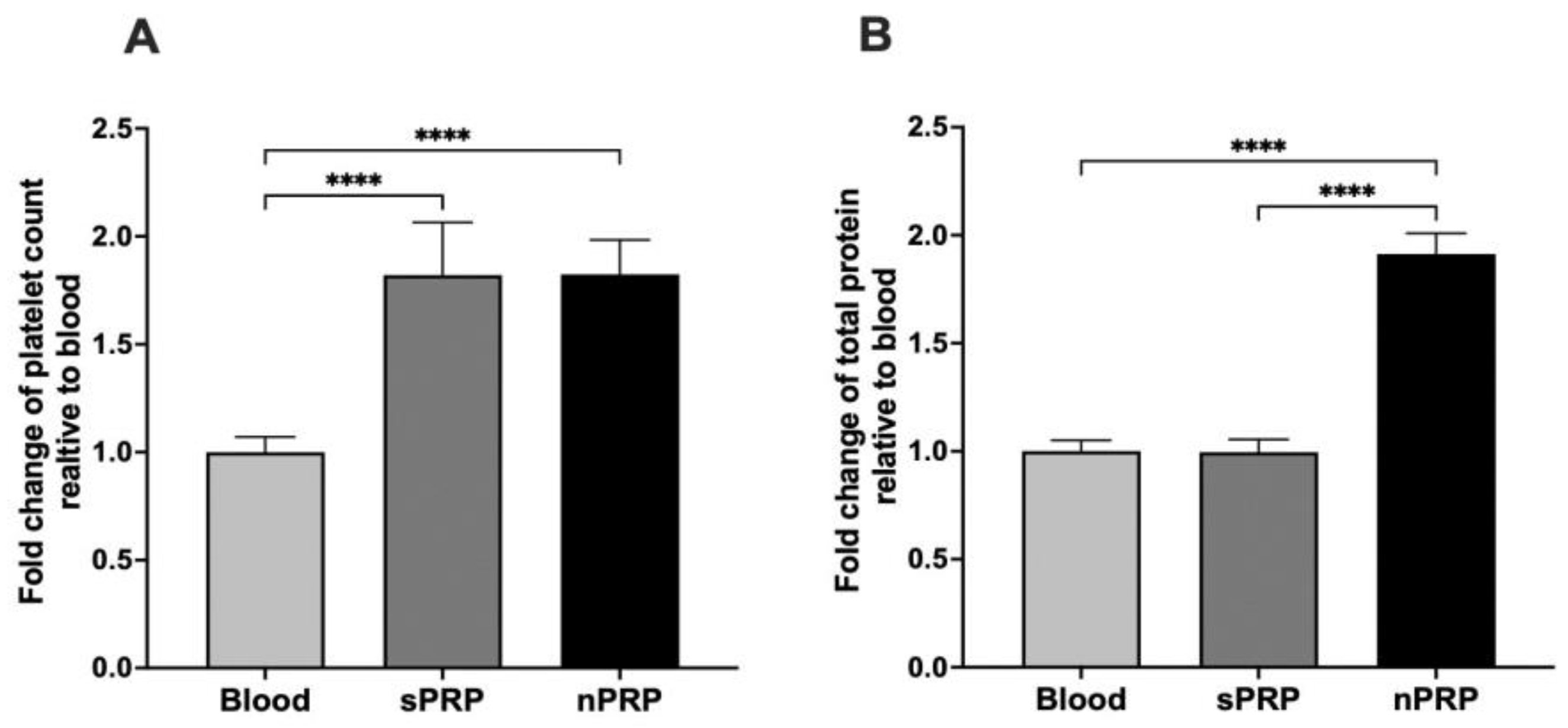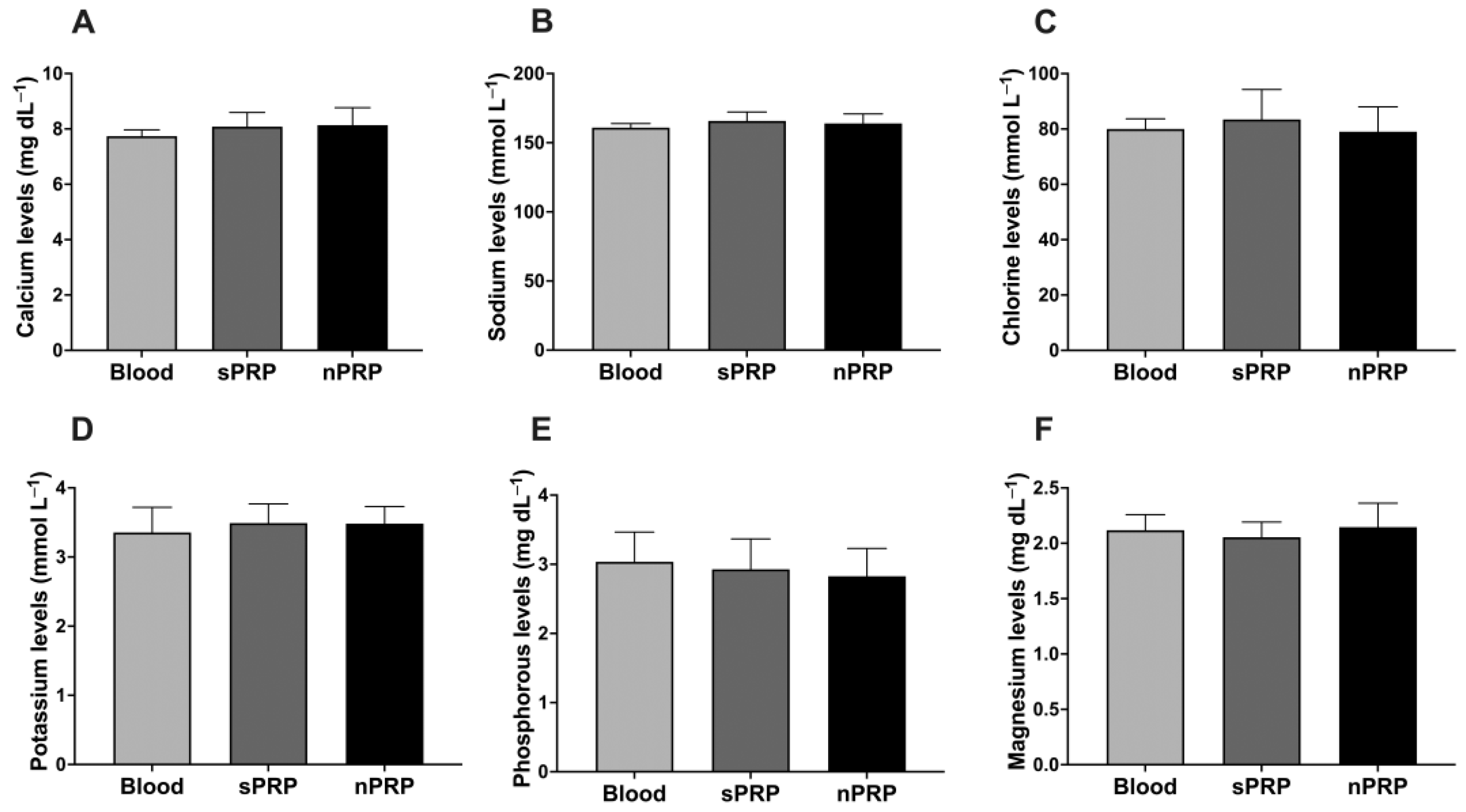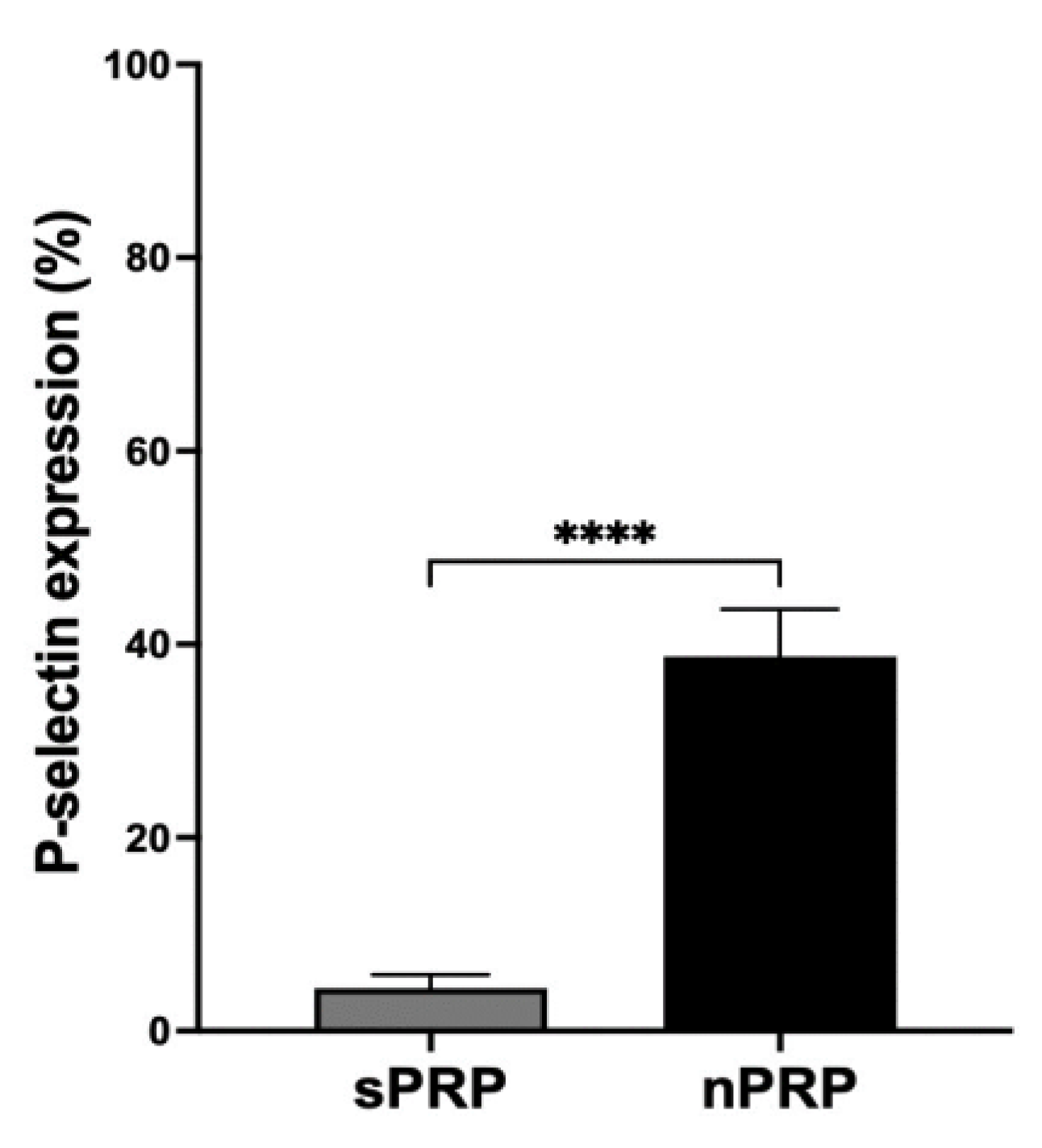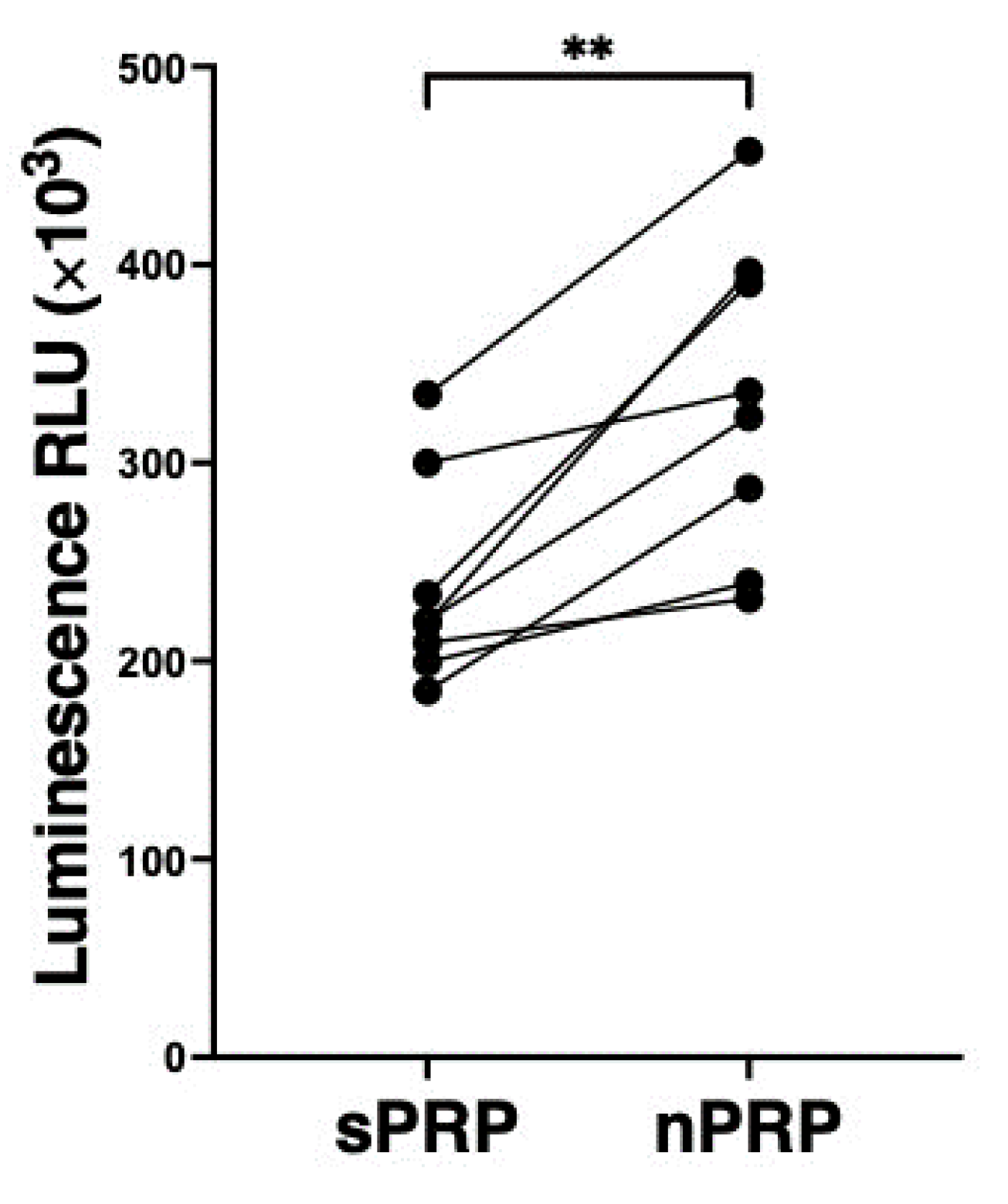Method Based on Ultrafiltration to Obtain a Plasma Rich in Platelet and Plasma Growth Factors
Abstract
:1. Introduction
2. Materials and Methods
2.1. Donors
2.2. Standard Platelet-Rich Plasma (sPRP) Preparation
2.3. Novel Platelet-Rich Plasma (nPRP) Preparation
2.4. Haematology and Protein Parameters
2.5. Ion Concentration Analysis
2.6. Platelet Activation Test
2.7. Quantification of GFs
2.8. Cell Culture
2.9. Cell Viability Assays
2.10. Statistical Analysis
3. Results
3.1. nPRP Characterization
3.2. Determination of Ion Levels in Plasma Samples
3.3. P-Selectin Expression Detection for Activated Platelet Detection
3.4. Growth Factor Profile in sPRP and nPRP
3.5. In Vitro Analysis of the Bioactivity of the nPRP
4. Discussion
5. Conclusions
Author Contributions
Funding
Institutional Review Board Statement
Informed Consent Statement
Data Availability Statement
Acknowledgments
Conflicts of Interest
References
- Lefrançais, E.; Ortiz-Muñoz, G.; Caudrillier, A.; Mallavia, B.; Liu, F.; Sayah, D.M.; Thornton, E.E.; Headley, M.B.; David, T.; Coughlin, S.R.; et al. The Lung Is a Site of Platelet Biogenesis and a Reservoir for Haematopoietic Progenitors. Nature 2017, 544, 105–109. [Google Scholar] [CrossRef]
- Lubkowska, A.; Dolegowska, B.; Banfi, G. Growth Factor Content in PRP and Their Applicability in Medicine. J. Biol. Regul. Homeost. Agents 2012, 26, 3S–22S. [Google Scholar] [PubMed]
- Marx, R.E. Platelet-Rich Plasma: Evidence to Support Its Use. J. Oral. Maxillofac. Surg. 2004, 62, 489–496. [Google Scholar] [CrossRef] [PubMed]
- Kiuru, J.; Viinikka, L.; Myllylä, G.; Pesonen, K.; Perheentupa, J. Cytoskeleton-Dependent Release of Human Platelet Epidermal Growth Factor. Life Sci. 1991, 49, 1997–2003. [Google Scholar] [CrossRef] [PubMed]
- Sánchez, A.R.; Sheridan, P.J.; Kupp, L.I. Is Platelet-Rich Plasma the Perfect Enhancement Factor? A Current Review. Int. J. Oral. Maxillofac. Implant. 2003, 18, 93–103. [Google Scholar]
- Saumell-Esnaola, M.; Delgado, D.; García Del Caño, G.; Beitia, M.; Sallés, J.; González-Burguera, I.; Sánchez, P.; López de Jesús, M.; Barrondo, S.; Sánchez, M. Isolation of Platelet-Derived Exosomes from Human Platelet-Rich Plasma: Biochemical and Morphological Characterization. Int. J. Mol. Sci. 2022, 23, 2861. [Google Scholar] [CrossRef]
- Aheget, H.; Tristán-Manzano, M.; Mazini, L.; Cortijo-Gutierrez, M.; Galindo-Moreno, P.; Herrera, C.; Martin, F.; Marchal, J.A.; Benabdellah, K. Exosome: A New Player in Translational Nanomedicine. J. Clin. Med. 2020, 9, 2380. [Google Scholar] [CrossRef]
- Beitia, M.; Delgado, D.; Mercader, J.; Sánchez, P.; López de Dicastillo, L.; Sánchez, M. Action of Platelet-Rich Plasma on In Vitro Cellular Bioactivity: More than Platelets. Int. J. Mol. Sci. 2023, 24, 5367. [Google Scholar] [CrossRef]
- Bendinelli, P.; Matteucci, E.; Dogliotti, G.; Corsi, M.M.; Banfi, G.; Maroni, P.; Desiderio, M.A. Molecular Basis of Anti-Inflammatory Action of Platelet-Rich Plasma on Human Chondrocytes: Mechanisms of NF-ΚB Inhibition via HGF. J. Cell Physiol. 2010, 225, 757–766. [Google Scholar] [CrossRef]
- Zhang, J.; Middleton, K.K.; Fu, F.H.; Im, H.-J.; Wang, J.H.-C. HGF Mediates the Anti-Inflammatory Effects of PRP on Injured Tendons. PLoS ONE 2013, 8, e67303. [Google Scholar] [CrossRef]
- Dhurat, R.; Sukesh, M. Principles and Methods of Preparation of Platelet-Rich Plasma: A Review and Author’s Perspective. J. Cutan. Aesthet. Surg. 2014, 7, 189–197. [Google Scholar] [CrossRef] [PubMed]
- Jacofsky, D.; Scott, M.; Smith, R.; Jennings, L.; Sowemimo-Coker, S.; Long, M.; Holbrook, J.; Granberry, L.; Kueter, T.; Cholera, S.; et al. Method to Prepare Platelet Rich Concentrate from Blood without a Centrifuge. 20 February 2005; 30, 1. [Google Scholar]
- Schmolz, M.; Stein, G.M.; Hubner, W.-D. An Innovative, Centrifugation-Free Method to Prepare Human Platelet Mediator Concentrates Showing Activities Comparable to Platelet-Rich Plasma. Wounds 2011, 23, 171–182. [Google Scholar] [PubMed]
- Dickson, M.N.; Amar, L.; Hill, M.; Schwartz, J.; Leonard, E.F. A Scalable, Micropore, Platelet Rich Plasma Separation Device. Biomed. Microdevices 2012, 14, 1095–1102. [Google Scholar] [CrossRef] [PubMed]
- Kim, C.-J.; Ki, D.Y.; Park, J.; Sunkara, V.; Kim, T.-H.; Min, Y.; Cho, Y.-K. Fully Automated Platelet Isolation on a Centrifugal Microfluidic Device for Molecular Diagnostics. Lab. Chip 2020, 20, 949–957. [Google Scholar] [CrossRef]
- Wu, Y.; Kanna, M.S.; Liu, C.; Zhou, Y.; Chan, C.K. Generation of Autologous Platelet-Rich Plasma by the Ultrasonic Standing Waves. IEEE Trans. Biomed. Eng. 2016, 63, 1642–1652. [Google Scholar] [CrossRef]
- Gifford, S.C.; Strachan, B.C.; Xia, H.; Vörös, E.; Torabian, K.; Tomasino, T.A.; Griffin, G.D.; Lichtiger, B.; Aung, F.M.; Shevkoplyas, S.S. A Portable System for Processing Donated Whole Blood into High Quality Components without Centrifugation. PLoS ONE 2018, 13, e0190827. [Google Scholar] [CrossRef]
- ART PRP Plus; Celling Biosciences: Austin, TX, USA, 2015.
- Zandim, B.M.; de Souza, M.V.; Magalhães, P.C.; Benjamin, L.d.A.; Maia, L.; de Oliveira, A.C.; Pinto, J.d.O.; Ribeiro Júnior, J.I. Platelet Activation: Ultrastructure and Morphometry in Platelet-Rich Plasma of Horses. Pesq. Vet. Bras. 2012, 32, 83–92. [Google Scholar] [CrossRef]
- Flow-Cytometric Analysis of Platelet-Membrane Glycoprotein Expression and Platelet Activation—PubMed. Available online: https://pubmed.ncbi.nlm.nih.gov/15226548/ (accessed on 29 November 2022).
- Riss, T.L.; Moravec, R.A.; Niles, A.L.; Duellman, S.; Benink, H.A.; Worzella, T.J.; Minor, L. Cell Viability Assays. In Assay Guidance Manual; Markossian, S., Grossman, A., Brimacombe, K., Arkin, M., Auld, D., Austin, C., Baell, J., Chung, T.D.Y., Coussens, N.P., Dahlin, J.L., et al., Eds.; Eli Lilly & Company and the National Center for Advancing Translational Sciences: Bethesda, MD, USA, 2004. [Google Scholar]
- Kon, E.; Di Matteo, B.; Delgado, D.; Cole, B.J.; Dorotei, A.; Dragoo, J.L.; Filardo, G.; Fortier, L.A.; Giuffrida, A.; Jo, C.H.; et al. Platelet-Rich Plasma for the Treatment of Knee Osteoarthritis: An Expert Opinion and Proposal for a Novel Classification and Coding System. Expert. Opin. Biol. Ther. 2020, 20, 1447–1460. [Google Scholar] [CrossRef]
- Sánchez, M.; Anitua, E.; Azofra, J.; Andía, I.; Padilla, S.; Mujika, I. Comparison of Surgically Repaired Achilles Tendon Tears Using Platelet-Rich Fibrin Matrices. Am. J. Sports Med. 2007, 35, 245–251. [Google Scholar] [CrossRef]
- Padilla, S.; Sánchez, M.; Vaquerizo, V.; Malanga, G.A.; Fiz, N.; Azofra, J.; Rogers, C.J.; Samitier, G.; Sampson, S.; Seijas, R.; et al. Platelet-Rich Plasma Applications for Achilles Tendon Repair: A Bridge between Biology and Surgery. Int. J. Mol. Sci. 2021, 22, 824. [Google Scholar] [CrossRef]
- Kellum, J.A. Determinants of Blood PH in Health and Disease. Crit. Care 2000, 4, 6. [Google Scholar] [CrossRef] [PubMed]
- Evanson, J.R.; Guyton, M.K.; Oliver, D.L.; Hire, J.M.; Topolski, R.L.; Zumbrun, S.D.; McPherson, J.C.; Bojescul, J.A. Gender and Age Differences in Growth Factor Concentrations from Platelet-Rich Plasma in Adults. Mil. Med. 2014, 179, 799–805. [Google Scholar] [CrossRef] [PubMed]
- Liao, J.-C. Positive Effect on Spinal Fusion by the Combination of Platelet-Rich Plasma and Collagen-Mineral Scaffold Using Lumbar Posterolateral Fusion Model in Rats. J. Orthop. Surg. Res. 2019, 14, 39. [Google Scholar] [CrossRef] [PubMed]
- IJMS|Free Full-Text|Apheresis Platelet Rich-Plasma for Regenerative Medicine: An In Vitro Study on Osteogenic Potential. Available online: https://www.mdpi.com/1422-0067/22/16/8764 (accessed on 29 August 2023).
- Andia, I.; Sánchez, M.; Maffulli, N. Basic Science: Molecular and Biological Aspects of Platelet-Rich Plasma Therapies. Oper. Tech. Orthop. 2012, 22, 3–9. [Google Scholar] [CrossRef]
- Arnoczky, S.P.; Sheibani-Rad, S. The Basic Science of Platelet-Rich Plasma (PRP): What Clinicians Need to Know. Sports Med. Arthrosc. Rev. 2013, 21, 180–185. [Google Scholar] [CrossRef]
- Olesen, J.L.; Heinemeier, K.M.; Haddad, F.; Langberg, H.; Flyvbjerg, A.; Kjaer, M.; Baldwin, K.M. Expression of Insulin-like Growth Factor I, Insulin-like Growth Factor Binding Proteins, and Collagen MRNA in Mechanically Loaded Plantaris Tendon. J. Appl. Physiol. 1985 2006, 101, 183–188. [Google Scholar] [CrossRef]
- Taniguchi, Y.; Yoshioka, T.; Sugaya, H.; Gosho, M.; Aoto, K.; Kanamori, A.; Yamazaki, M. Growth Factor Levels in Leukocyte-Poor Platelet-Rich Plasma and Correlations with Donor Age, Gender, and Platelets in the Japanese Population. J. Exp. Ortop. 2019, 6, 4. [Google Scholar] [CrossRef]
- Garg, A.K. The Use of Platelet-Rich Plasma to Enhance the Success of Bone Grafts around Dental Implants. Dent. Implant. Updat. 2000, 11, 17–21. [Google Scholar]






Disclaimer/Publisher’s Note: The statements, opinions and data contained in all publications are solely those of the individual author(s) and contributor(s) and not of MDPI and/or the editor(s). MDPI and/or the editor(s) disclaim responsibility for any injury to people or property resulting from any ideas, methods, instructions or products referred to in the content. |
© 2023 by the authors. Licensee MDPI, Basel, Switzerland. This article is an open access article distributed under the terms and conditions of the Creative Commons Attribution (CC BY) license (https://creativecommons.org/licenses/by/4.0/).
Share and Cite
Mercader Ruiz, J.; Beitia, M.; Delgado, D.; Sánchez, P.; Guadilla, J.; Pérez de Arrilucea, C.; Benito-Lopez, F.; Basabe-Desmonts, L.; Sánchez, M. Method Based on Ultrafiltration to Obtain a Plasma Rich in Platelet and Plasma Growth Factors. J. Clin. Med. 2023, 12, 5941. https://doi.org/10.3390/jcm12185941
Mercader Ruiz J, Beitia M, Delgado D, Sánchez P, Guadilla J, Pérez de Arrilucea C, Benito-Lopez F, Basabe-Desmonts L, Sánchez M. Method Based on Ultrafiltration to Obtain a Plasma Rich in Platelet and Plasma Growth Factors. Journal of Clinical Medicine. 2023; 12(18):5941. https://doi.org/10.3390/jcm12185941
Chicago/Turabian StyleMercader Ruiz, Jon, Maider Beitia, Diego Delgado, Pello Sánchez, Jorge Guadilla, Cristina Pérez de Arrilucea, Fernando Benito-Lopez, Lourdes Basabe-Desmonts, and Mikel Sánchez. 2023. "Method Based on Ultrafiltration to Obtain a Plasma Rich in Platelet and Plasma Growth Factors" Journal of Clinical Medicine 12, no. 18: 5941. https://doi.org/10.3390/jcm12185941
APA StyleMercader Ruiz, J., Beitia, M., Delgado, D., Sánchez, P., Guadilla, J., Pérez de Arrilucea, C., Benito-Lopez, F., Basabe-Desmonts, L., & Sánchez, M. (2023). Method Based on Ultrafiltration to Obtain a Plasma Rich in Platelet and Plasma Growth Factors. Journal of Clinical Medicine, 12(18), 5941. https://doi.org/10.3390/jcm12185941







